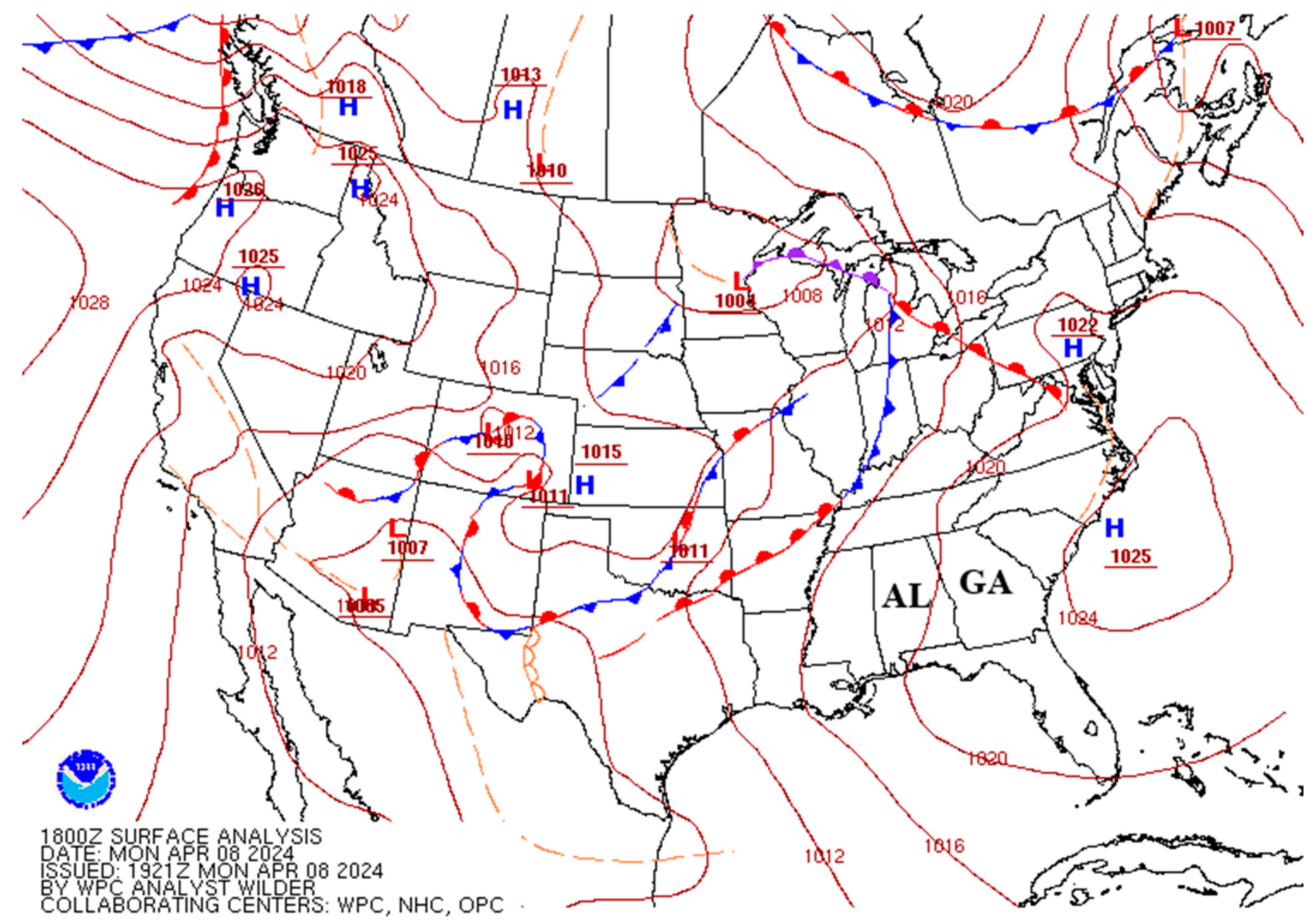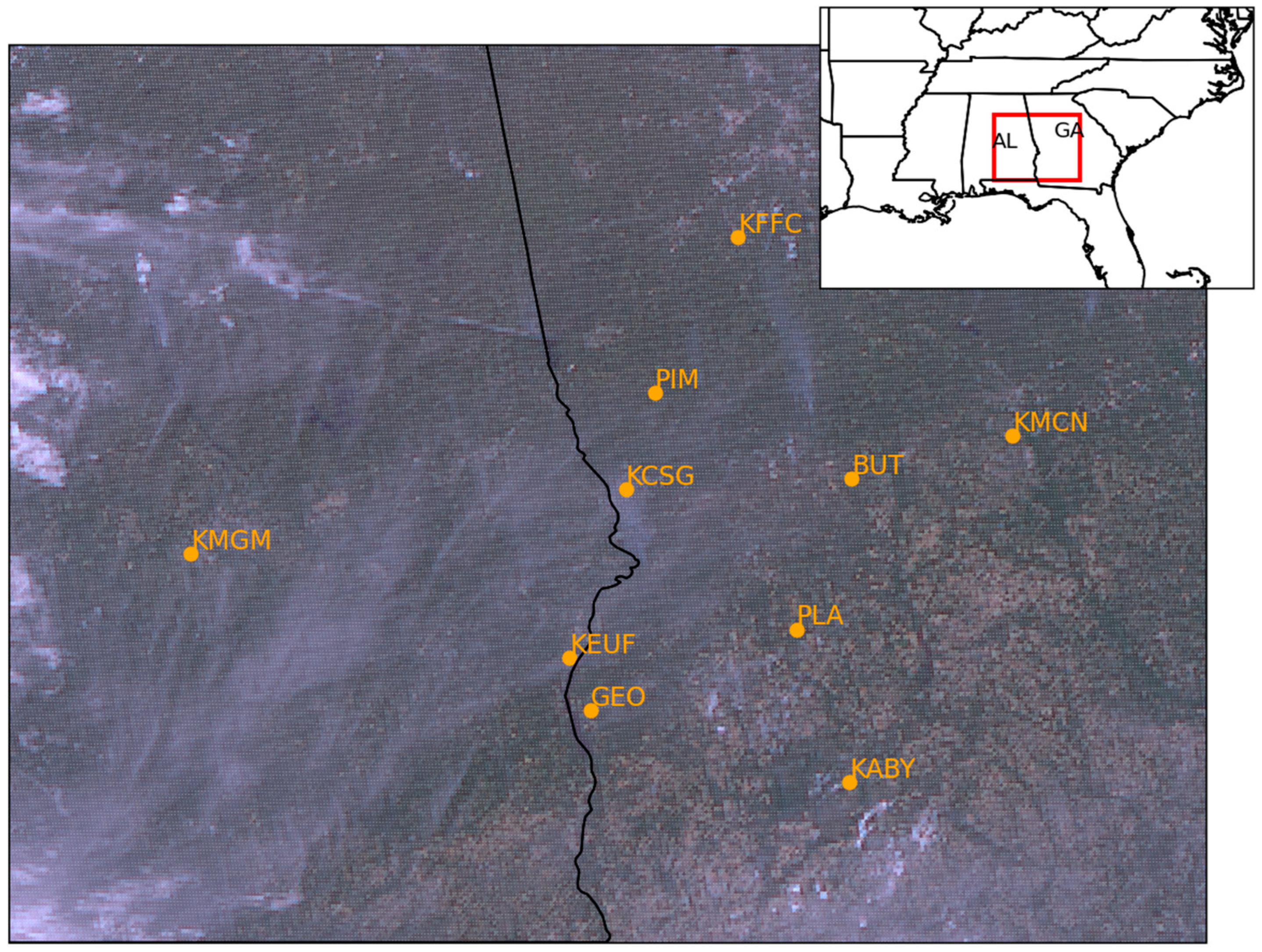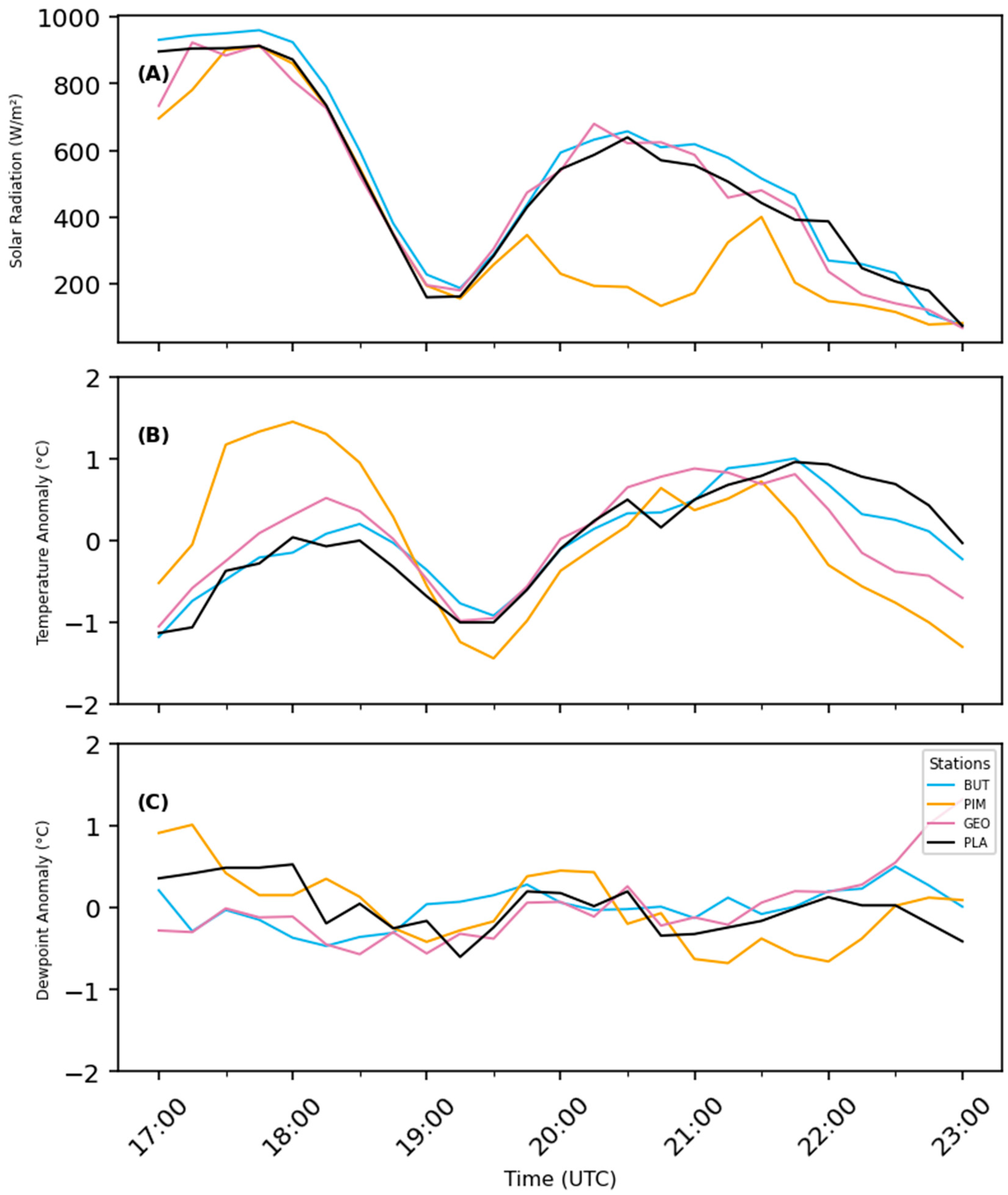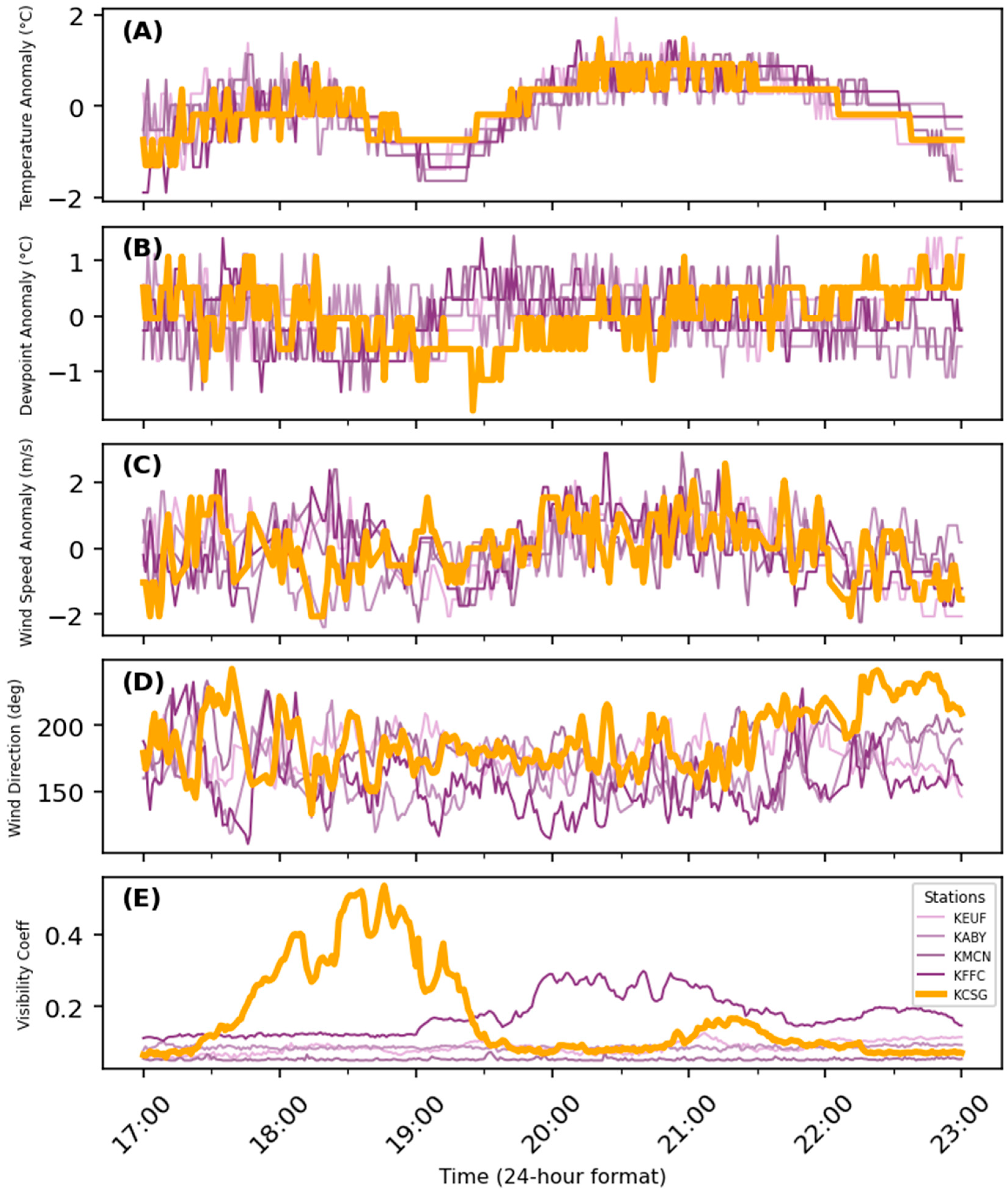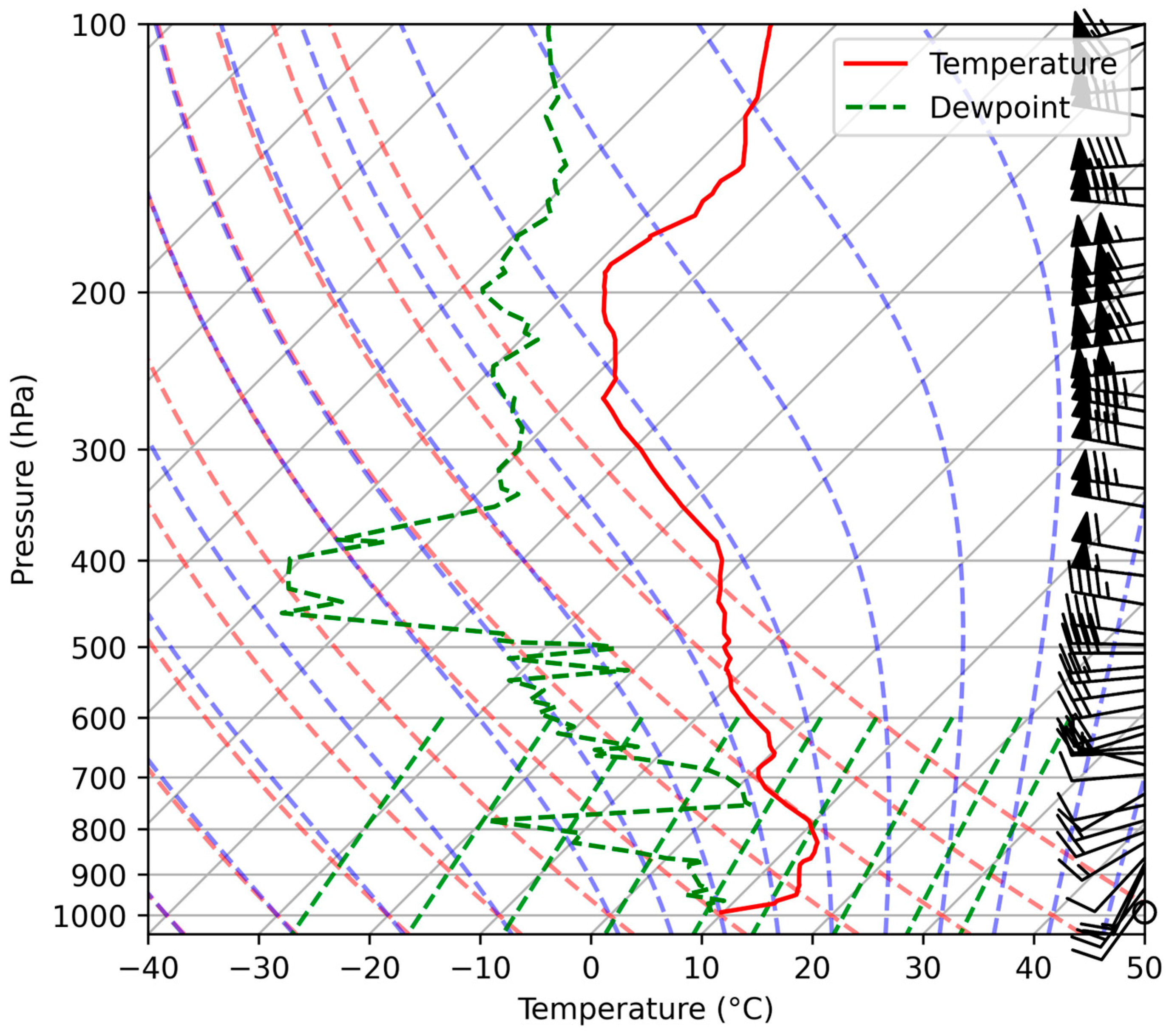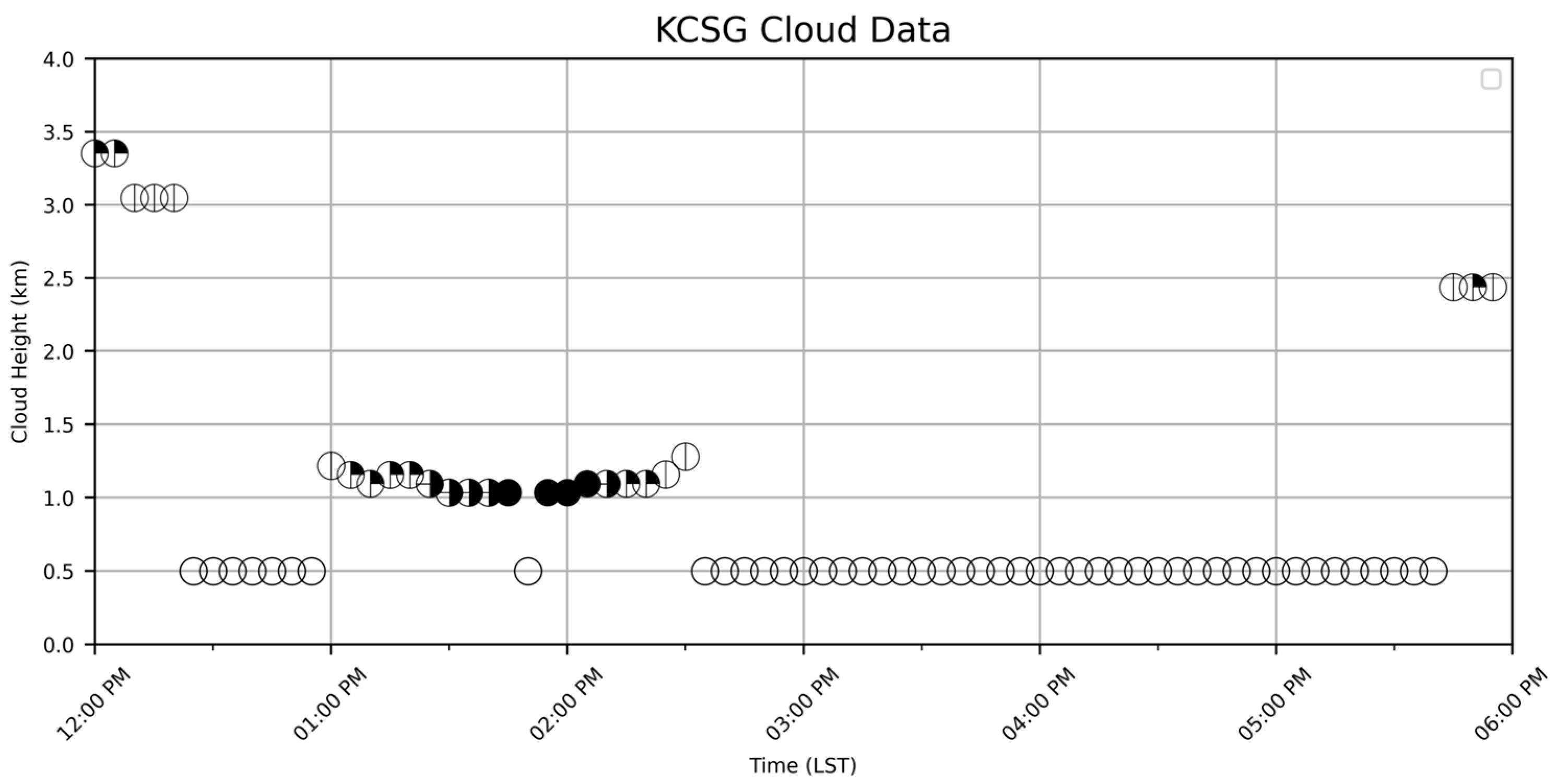1. Introduction
On the afternoon of 8 April 2024, much of the eastern and central USA experienced a solar eclipse, with the path of totality stretching from Texas to Vermont. The eclipse attracted crowds in and out of the zone of totality to view this rare event. In Columbus, Georgia, USA, where the maximum obscuration reached 78.7%, smoke from a nearby prescribed fire modified the radiation budget during the eclipse, further altering eclipse-induced perturbations to surface conditions. This contribution presents data from Columbus and other regional surface observation stations to evaluate the relative impact of the presence of smoke on surface conditions during the eclipse. A careful analysis of the literature frames these observations in the context of the existing knowledge with respect to the effects of eclipses and smoke, developing a framework that suggests how changing turbulence regimes may play a role in the surface layer response during an eclipse.
The behavior of surface weather parameters during solar eclipses has been extensively studied. Decreases in surface temperature are first detected when the sun has become about half-covered, declining to a minimum for up to 20 min after the maximum obscuration [
1]. Observations show that the surface temperature depression during an eclipse typically ranges from less than 2 °C to 7 °C, depending on factors such as the amount of obscuration, cloud cover, and time of day [
2,
3]. For cloud-free locations in the zone of totality, a more consistent range 3.5 °C to 5 °C is more commonly observed [
4,
5], a finding supported by numerical simulations [
6]. The time of maximum temperature depression has been found to lag behind the time of peak eclipse by approximately 15–20 min [
5,
7].
The surface specific humidity response has been shown to vary during eclipses. In some instances, low-level moisture is observed to decrease during an eclipse [
8], with the decrease capable of persisting for several hours after maximum obscuration [
9]. Under cloudy skies, little change in specific humidity may be evident [
10]. Local advection of water vapor may increase the specific humidity during an eclipse [
5]. During the annular solar eclipse of 15 January 2010 in India, measurements of latent heat flux were found to eliminate evaporation as the cause of the observed drying; therefore, the observed decrease in specific humidity in the surface layer was attributed to enhanced subsidence during the eclipse [
9].
The onset of totality may be accompanied by a burst of wind [
11], sometimes referred to as the “eclipse wind” [
12]. Before totality, 10-m wind speeds generally decrease in tandem with the reduction in sunlight, reaching a minimum before maximum obscuration and recovering as insolation returns [
5,
8,
13]. This slowing of wind after eclipse onset has been connected with the stabilization of the lower boundary layer [
13]. Wind direction tends to back near the time of maximum obscuration, which is commonly followed by a period of veering winds that suggests similarity to nocturnal onset and the early stages of nocturnal low-level jet formation [
12].
Solar eclipses induce boundary layer stabilization, with this effect persisting for up to 45 min after peak eclipse [
14]. Turner et al. [
15] observed increasing stability with height, which was likely produced by local variations in latent and sensible heat over a heterogeneous surface, with additional contributions from warm advection in the lowest 1 km of the boundary layer. Fine-wire temperature measurements show that the turbulence intensity parameter drops by nearly half from pre-eclipse conditions to peak eclipse [
10]. Similarly, measurements of turbulent kinetic energy (TKE) during the 21 August 2017 eclipse in Oklahoma further confirm turbulent dissipation during totality, with minimum TKE coinciding with a minimum in water vapor variance in the lower boundary layer [
15]. Flights by unmanned aerial vehicles [UAVs] can increase the temporal resolution of boundary layer measurements, capable of capturing changes that radiosondes cannot detect [
16].
On 8 April 2024, weather conditions over Georgia were dominated by a high-pressure center located just off of the east coast at the North Carolina/South Carolina border (
Figure 1). Under the influence of this high, surface winds were weak to moderate across Georgia with speeds from 2.5 to 5 m/s. The main low pressure center was located over eastern Minnesota, with a frontal boundary draped from Michigan to Texas. A mid-tropospheric ridge axis was located over Georgia, and a broad trough was located over the southwest U.S. A wide southwesterly upper-level jet reached from the northern Gulf of Mexico to Iowa, advecting a large cirrus shield toward Georgia from the west as the eclipse began. The absence of synoptic and mesoscale weather systems over Alabama and Georgia, and the absence of moisture and temperature gradients in the vicinity of Columbus, make this an ideal event via which to study local eclipse impacts.
While observing the 8 April 2024 eclipse on the Columbus State University main campus, the first author noted a smoky haze against a backdrop of blue sky, interrupted by sparse cirriform clouds. Southerly winds at this time suggest that the likely source of the smoke was a prescribed fire originating from Fort Benning, which is located due south of Columbus. Prescribed fires are conducted in one-to-three-year cycles in forested environments on Fort Benning to reduce fuels for natural wildfires, control understory growth, and maintain ecosystem health (J. Parker, personal communication, April 2025) [
17].
This study reports the results of a unique “natural experiment” that occurred during the 8 April 2024 eclipse. It is uncommon for nature to provide scenarios that create simultaneous control and experimental settings under equal forcing, allowing for independent evaluation of atmospheric responses. In this scenario, a narrow smoke plume passed directly over Columbus, Georgia during the eclipse. Two small datasets are used for comparison: four Georgia Weather Network (GWN) meso-net stations surrounded by trees and situated approximately 40–110 km from Columbus; and five Automated Surface Observing Stations (ASOS) located at regional airports, at a generally greater distance from Columbus. An absence of clouds (except for stray cirrus), a lack of strong temperature or moisture gradients, and a lack of mesoscale and synoptic forcing maintained the system in a more-or-less closed state. This dataset permits the testing of eclipse response under near-equal radiative forcing in three environments: smoky (Columbus), wooded clear air (GWN), and open clear air (ASOS). The goals of this paper are to highlight key results from this natural experiment; to evaluate contributions from thermal and mechanical turbulence in smoky and clear environments based on the available surface observations; and to propose a hypothesized mechanism that may partially explain the greater thermal buffering observed in a smoky environment.
2. Materials and Methods
Surface observations in the immediate Columbus, GA area during the 8 April 2024 eclipse were limited. The Columbus ASOS station (KCSG) is located at Columbus Airport, on the north side of the city and a short distance from the main campus of Columbus State University, where the first author observed the eclipse. Columbus State University operates a weather station at Oxbow Environmental Learning Center (OELC), situated on the southern side of Columbus, just outside of the northern entrance to Fort Benning and placing it much closer to the origin of the smoke plume. Reliable data are unavailable for OELC on this date due to equipment malfunction.
One-minute and five-minute data were obtained from the Iowa Environmental Mesonet (IEM) website [
18] for the closest available ASOS sites in Alabama and Georgia, which include KCSG, Albany (KABY), Macon (KMCN), and Peachtree City (KFFC) in Georgia, as well as Eufaula (KEUF) in Alabama (
Figure 2). Surface observations at Montgomery, AL (KMGM) were examined but were highly influenced by larger-scale weather patterns, which made the data unsuitable for comparison with the other stations.
ASOS stations are sited at airports. They tend to be sited in wide-open areas with minimal tree cover. One-minute ASOS data were not available through the National Center for Environmental Information at the time of writing. The IEM one-minute temperature and dewpoint data were available at a precision of 1°F and subsequently converted to degrees Celsius. While this lack of precision limits the detection of more subtle responses, it enhances the visibility of overall trends in the data by reducing noise. Hourly ASOS data (collected from the IEM website) for several other stations in the vicinity of Columbus were examined, primarily to determine the presence of any smoke, haze, or low-level cloud cover around the time of the eclipse. The temporal resolution at these other stations was too coarse for comparison with the ASOS stations at larger airports.
The nearest surface observing stations to KCSG—Butler (BUT), Plains (PLA), Georgetown (GEO) and Pine Mountain (PIM), Georgia—are part of the Georgia Weather Network (GWN), run by the University of Georgia. The GWN stations are often situated near trees (P. Knox, personal communication, January 2025) [
19]. Air temperature and dewpoint temperature are reported to the nearest hundredth of a degree Celsius, wind speed to the nearest thousandth of a meter per second, and wind direction to the nearest hundredth of a degree. The GWN stations report solar radiation but do not report cloud cover. While GWN stations offer higher precision of measurement, they report at 15-min intervals, which limits their ability to capture rapid fluctuations in eclipse-driven responses.
The 1200 Universal Time Coordinate (UTC) sounding at Peachtree City, Georgia (KFFC) on 8 April 2024 was obtained from the University of Wyoming upper air sounding archive to seek evidence of a capping inversion [
20]. Geostationary Operational Environmental Satellite-16 (GOES-16) data were obtained through Amazon via the National Oceanic and Atmospheric Administration (NOAA) Weather and Climate Toolkit [
21] and were used to confirm cloud cover and to seek confirmation of the smoke plume originating from the prescribed fire. ChatGPT v.4.5 facilitated the writing of Python 3 codes to display the data. All ASOS, GWN, and satellite data referenced in this publication are included in a
Supplementary Materials File that accompanies this article.
3. Results
True-color satellite imagery to detect the smoke plume is unavailable during the eclipse window owing to the lack of incoming shortwave energy. In the available true- color satellite imagery from before the eclipse (
Figure 2), the smoke plume is visible as an enhanced region of cloud cover immediately south of KCSG. The presence of high cloud cover makes it difficult to separate the extent of the smoke plume from the extent of the cloud cover. Per visibility observations at KCSG, the smoke dissipated at KCSG at approximately 1930 UTC.
In Columbus, the eclipse began at 1743 UTC. Solar radiation began to decrease at 1745 UTC at BUT and PIM (the nearest GWN stations to KCSG;
Figure 3A). At KCSG, the maximum obscuration of 78.7% occurred at 1902 UTC. Solar radiation reached a minimum value of 186.6 W-m
−2 at BUT and a minimum value of 155.3 W-m
−2 at PIM, both of which occurred at 1915 UTC (
Figure 3A). Solar radiation data are not available for the ASOS stations. The response in solar radiation following the eclipse indicated clear skies at all GWN stations except PIM, which is located northeast of Columbus. The cloud cover at PIM, which is located downwind of Columbus for this case, likely resulted from aerosol loading by the smoke plume. Satellite data show no evidence of either cloud cover or the smoke plume after the region emerges from the eclipse shadow. Due to the lack of observed clouds, the smoke plume is more likely to be responsible for the observed reduction in radiation at PIM beginning at 1945 UTC. More discussion of these observations is provided later in this section. The eclipse ended at 2018 UTC in Columbus. For surrounding stations, the time of maximum obscuration was within 4 min of that at KCSG, and the maximum obscuration was within 5%.
The arrival of smoke at KCSG was marked by an increase in the visibility coefficient beginning at 1730 UTC, 13 min before eclipse onset (
Figure 4D). Increasing visibility coefficient corresponds to a decrease in visibility. Between 1800 UTC and 1830 UTC, the visibility coefficient continued to increase at KCSG. By 1852 UTC, the KCSG temperature had reached its minimum (23.9 °C) and remained constant for the next 34 min (within the limits of precision of the temperature data;
Figure 4A). This duration of constant temperature far exceeds that of surrounding ASOS stations and suggests a more rapid and stronger stabilization of the boundary layer than would be produced without a layer of smoke. The visibility coefficient began to diminish at approximately 1915 UTC (13 min after maximum obscuration), and visibility had returned to baseline by 1930 UTC, about 45–50 min before the end of the eclipse. There is no evidence that any other ASOS station was affected by smoke to the same extent as at KCSG during the eclipse.
Temperature depression is defined as the difference between the maximum temperature from the two hours prior to maximum obscuration and the minimum temperature from the hour following maximum obscuration [
7]. The temperature depression at KCSG was 1.7 °C. Among ASOS stations, the next closest value was 2.2 °C at KFFC and KEUF. The limited precision of ASOS temperature data may underestimate the difference in temperature depression. In comparison, the minimum temperature depression among GWN stations was 1.04 °C at PLA, and the maximum temperature depression was 2.89 °C at PIM. The wider range of temperature response at GWN stations is likely attributable, at least in part, to the variability in vegetation surrounding the stations and to the impact of the smoke plume at PIM, which was located farther downwind of the fire than KCSG. Differences in measuring equipment between ASOS and GWN stations might also contribute to the observed differences in temperature depression measurements. The temperature began to decrease at most GWN (
Figure 3B) and ASOS (
Figure 4A) stations between 1800 UTC and 1830 UTC and continued to fall until about 1900 UTC, at which time the temperature became constant, to the degree of precision of the one-minute ASOS data. With this lack of precision, the time from maximum obscuration to minimum temperature at KCSG cannot be determined.
Beginning at 1800 UTC, temperature and wind speed decreased at these other ASOS stations in response to reduced shortwave forcing. The other ASOS stations showed variability throughout the 34-min time period during which temperature remained constant at KCSG. The temperature began to rise at other ASOS stations around 1915 UTC and reached a relative maximum around 2030 UTC. There were no major differences in the timing of the thermal response in smoky and clear air, suggesting that changes in shortwave forcing drive temperature changes without a lagged response. All GWN stations showed similar responses in temperature, including at PIM, which experienced reduced solar radiation beginning at 1945 UTC.
The dewpoint temperature remained relatively constant at other ASOS stations (
Figure 4B) before eclipse onset. In contrast, dewpoint decreased at all four GWN stations (
Figure 3C) from 1800 UTC to about 1900 UTC (maximum obscuration). The dewpoint rose at most ASOS stations from 1900 to 1930 UTC and at all four GWN stations from 1930 to 2030 UTC. At KCSG, the dewpoint decreased during this window, as the visibility returned to normal. The dewpoint remained relatively lower at KCSG than at the other stations during the post-peak phase of the eclipse, until about 2010 UTC. The dewpoint decreased after 1845 UTC at all four GWN stations and remained constant at several ASOS stations (including KCSG), until about 2230 UTC, when it began to rise.
Wind data are not discussed or displayed for the GWN stations because noise and lack of temporal precision obscured any trends in the data. For the ASOS stations, wind speed (
Figure 4C) responded similarly to air temperature, in that the wind speed began to trend downward beginning at 1900 UTC. The wind speed at KCSG and KABY generally increased from 1825 to 1900 UTC, while the wind speed at other ASOS stations generally decreased. At KCSG, a sudden burst of wind occurred at the time of maximum obscuration for about 15 min: the eclipse wind. The other ASOS stations showed a much weaker peak in wind speed at this time, or no peak at all. The wind speed then increased at all ASOS stations from approximately 1920 UTC to approximately 2000 UTC, likely influenced by increasing destabilization of the boundary layer as sunlight grew in intensity.
The wind direction was much less variable at KCSG following the eclipse wind until 1955 UTC. This reduction in variability of wind direction began as the smoke coverage was waning and continued after the smoke had dissipated. Veering winds occurred beginning at maximum obscuration at the ASOS stations but were more prominent beginning approximately 45 min after the end of the eclipse and continuing for about an hour. At KCSG, the wind veered from 1800 to 1930 UTC. The event concluded with nearly steady-state winds, temperature, and dewpoint.
The first author observed that a smoky haze was concentrated at the top of the boundary layer, with clear blue sky visible just above the smoke layer. This suggests that either moderate convection persisted in the boundary layer throughout the duration of the eclipse or that buoyancy was provided by the advected smoky air itself to loft the smoke to the top of the boundary layer. Alternatively, Doppler lidar observations of the boundary layer during the 21 August 2017 eclipse in Kentucky noted oscillations present throughout the boundary layer, with regular wave motions most prominent in the region of greatest static stability, which lies just below the capping inversion [
5]. It is possible that these wave motions at that height, if present, might have helped to maintain peak concentration of smoke at the top of the boundary layer. The 1200 UTC KFFC sounding (
Figure 5) featured a prominent capping inversion at approximately 1.2 km, which is in line with the estimated height of the smoke as viewed by the first author and with the cloud cover reports shown in
Figure 6 and discussed below.
In general, sky conditions across western Georgia and eastern Alabama were mostly reported as clear throughout the duration of the 8 April 2024 eclipse. At KCSG, clouds were reported at approximately 3-km elevation around 1700 UTC and later in the day between 2100 and 2200 UTC, as is shown in
Figure 6. These reports did not include the cirriform clouds visible in satellite data approaching from the west, as they likely exceeded the vertical range of the ceilometer. KCSG reported a growing blanket of clouds (
Figure 6) at the approximate height of the capping inversion from 1800 to 1930 UTC, in agreement with the reported changes in visibility during this time. No clouds at such a height were visible to the first author at this time, suggesting that the ceilometer was likely detecting an elevated layer of haze rather than true cloud. Roughly coincident with the cloud reports, haze at the surface was reported at KCSG from 1805 to 1920 UTC. Haze is reported when the ASOS visibility sensor detects a reduction in light scattering by particles too small to be detected by the present weather sensor [
22]. Furthermore, a haze report must occur in a relatively dry environment.
As shown by the reports in
Figure 6, this blanket of haze grew in coverage and lowered in height until 1845 UTC and then receded in coverage while rising in height from 1855 to 1930 UTC. Mixing layer depth and cloud base height have been commonly shown to follow this pattern during eclipses [
10,
23]. The cloud growth process was interrupted by a (likely spurious) report of clear skies at 1850 UTC. The reported cloud heights suggest a maximum smoke plume rise of 1.3 km, as indicated by the KCSG cloud reports, which aligns with the typical value for prescribed burns of approximately 1 km [
24]. Although Pasken et al. [
16] noted a much more rapid decrease in boundary layer height, the timing of the KCSG cloud cover reports aligns with the timing of surface reports of haze but not with the timing of the eclipse maximum, supporting the interpretation of a smoke plume advecting over the area. In a similar instance of a spurious cloud report, Evan et al. [
25] noted the misidentification of a dust cloud as a cloud by an Aerosol Robotic Network (AERONET) station in southeastern California.
5. Conclusions
This paper examines surface observations during the solar eclipse on 8 April 2024 in Columbus, Georgia, where smoke from a nearby prescribed fire influenced the boundary layer response to rapid shortwave radiation loss. Ideal weather conditions and a near-Gaussian smoke incursion make this case a highly idealized natural experiment through which to explore the influence of smoke during a rapid, transient change in shortwave radiation relative to clear conditions. The effect of the smoke at KCSG was to produce a temperature depression that was approximately 0.5 °C warmer than at surrounding ASOS stations. At GWN meso-net stations, where vegetation was more extensive, the temperature depression also tended to be reduced, illustrating that the surface layer response is highly sensitive to the local environment under rapid shortwave forcing. In the smoky environment at KCSG, surface responses were more complex than at other ASOS stations: the eclipse wind was more pronounced, and the post-eclipse warming was notably delayed. Despite the additional complexity of the response in the smoky environment, the timing of transitions between turbulence regimes was unaffected by smoke.
We have proposed that population dynamics of aerosol growth and their influence on moisture in the environment may help to reinforce steady-state conditions in temperature and dewpoint at the surface during the peak phase of the eclipse. Future work could test this hypothesis by analyzing high-resolution visibility and aerosol data throughout eclipse periods under both clear and smoky conditions. Evidence for this phenomenon could be obtained by instruments such as aerosol counters and particle sizers, which could measure changes in aerosol size distributions. Flux tower measurements of latent heat in the boundary layer under smoky conditions could provide evidence for the role of subtle fluctuations in latent heating. Similarly, the use of hygrometers on unmanned aerial vehicle (UAV) flights could determine whether a subtle vertical redistribution of moisture or latent heat occurs, particularly near eclipse maximum. Integrating such findings into numerical simulations that account for changes in aerosol size may offer a theoretical means to test the plausibility of the proposed Subcritical Aerosol-Moisture Feedback (SAMF) response between aerosol growth and relative humidity. By considering boundary layer processes, aerosols, and eclipse-induced radiative fluxes in smoky and clear environments, this study offers a novel framework for future research. We hope that our approach leads to new insights into how the interactions between aerosols, moisture, and radiation shape boundary layer conditions, particularly during eclipses.
